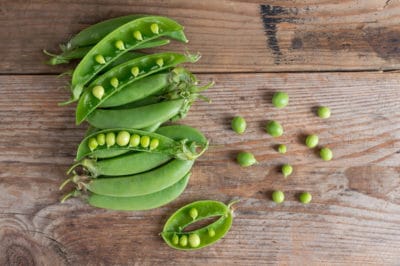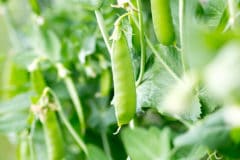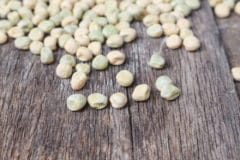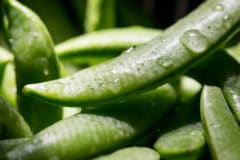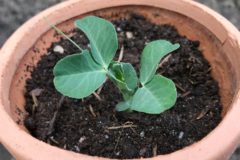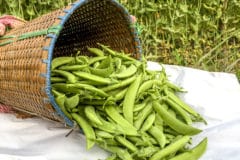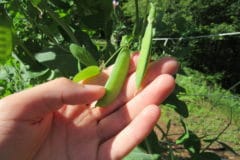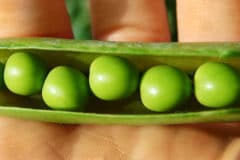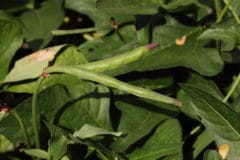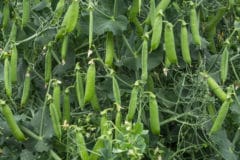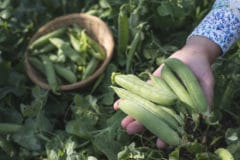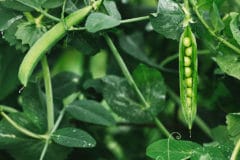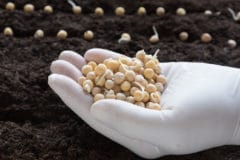How to Plant Sugar Snap Peas
Plant peas early in the spring. They can take a frost and will grow through a snow blanket. Ideal germination temperatures are between 45-55°F (7-12°C). Place them in full sun and well draining soil. Amend the soil with 1-3 inches of compost worked in, avoid nitrogen heavy fertilizers.
Soak pea seeds overnight to speed germination. You can inoculate the soaking water with rhizobial bacteria found at garden supply stores. This bacteria forms a symbiotic relationship with peas and beans to supply nitrogen to the pea plant and surrounding plants. Inoculant can also be added directly to the soil, though most healthy organic soils will already contain it.
Directly plant peas outdoors 1 1/2 inches deep and 2 inches apart in rows. Planting them along a wire fenceline allows them to climb the fence. Otherwise keep in mind they will need a trellis to support their climbing growth.
Peas have delicate root systems and don’t react well to transplanting. Because they grow so early in the season anyway, there isn’t much of a benefit to starting them indoors.
How to Care for Sugar Snap Peas
Water regularly and avoid letting the soil dry out completely. Build a support trellis using branches, wire fencing, wood, garden twine, or just about anything you have around. The height of the trellis will depend on the growth habits of your pea variety. Some grow taller than others. Here is a list of some popular snap pea varieties:
- Ann Snap Pea – Short and Bushy, Sweet, Early Ripener
- Magnolia Blossom Tendril – Bi-Color Flowers, Open Growth Habit, 7 Foot tall, 70 Days
- Sugar Magnolia Tendril – Purple Pods, Sweet Peas, Ornamental, 8 Foot tall
Bushy varieties like the Ann Snap Pea are the best type for container gardening. Row-trellises work excellent for the taller varieties if planted in rows in the garden. Mulching around the base of plants once the peas are established will help keep the roots cool and the weeds down. Pea roots are shallow so avoid digging at the earth around them.
Harvest and Storage
Sugar snap peas will produce loads of pods for weeks on end if kept healthy in the garden. There’s no need to wait until the peas inside the pod are ready, you can harvest pods as soon as they grow for a sweet treat. That is the beauty of snap peas. Eat them fresh while they’re young, and shell them when they are mature. Use both hands when pulling pods off the vine to give yourself leverage so you don’t rip the vine apart.
The peas inside are ready to harvest when the pods have fully rounded out similar to a shelling pea. They should feel plump and juicy not dry. Sugar snap peas are the traditional pea used in split pea soup, so don’t hesitate to try your hand at drying them in a dehydrator for later recipes.
To store them fresh, leave them in the pod and place them in a plastic bag in the fridge for up to a week. The whole pods or just the peas themselves can both be frozen and later thawed into stir fries and soups.
Tips and Tricks
Rotate peas around the garden from year to year, and allow their root sysems to compost in place. This releases nitrogen into the soil for the next crop planted. They also feed companion plants while living and will grow happily next to anything that isn’t a pea or a bean.
The most damaging pests in the pea garden are slugs and pea moths. If you live in an area prone to pea moths, consider planting early ripening varieties and avoid having your peas mature after the moths wake up for the year. Slugs can be hand-picked or bated using homemade traps. Ducks offer great slug control, and once pea plants grow tall they can’t do much damage to the upper fruit.
Powdery mildew can be an issue in wet climates. Space your peas farther apart to allow good airflow in wet climates and avoid using leaf mold as mulch which can carry the fungus.
